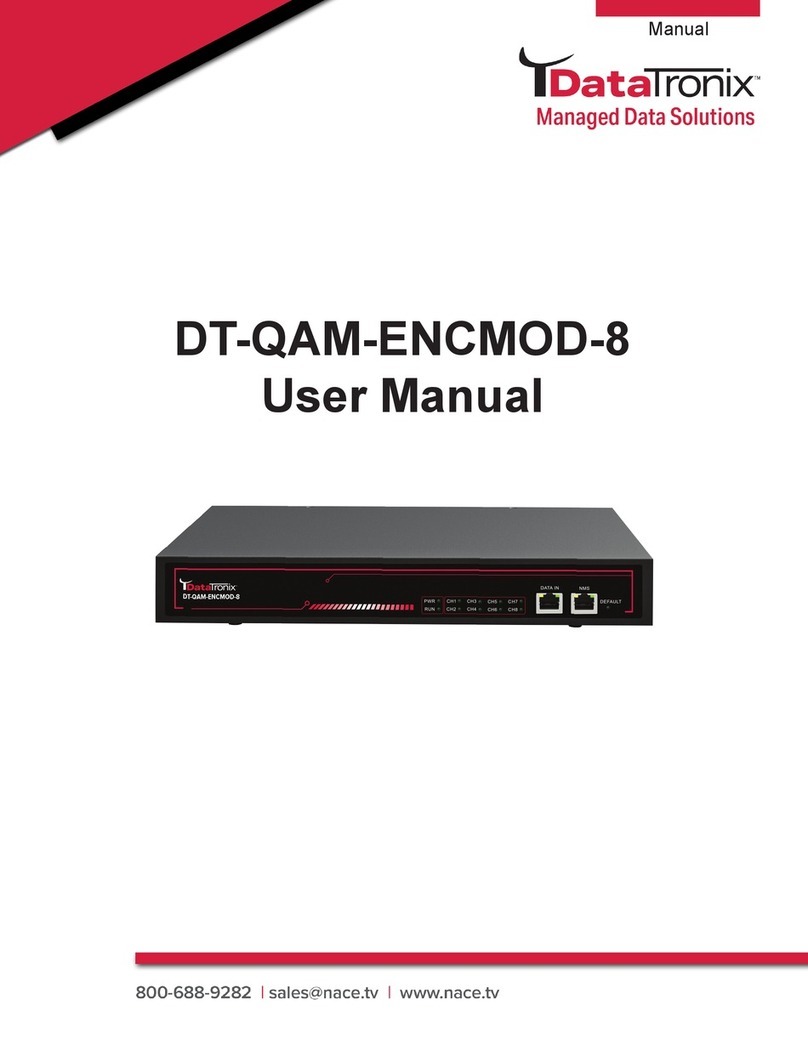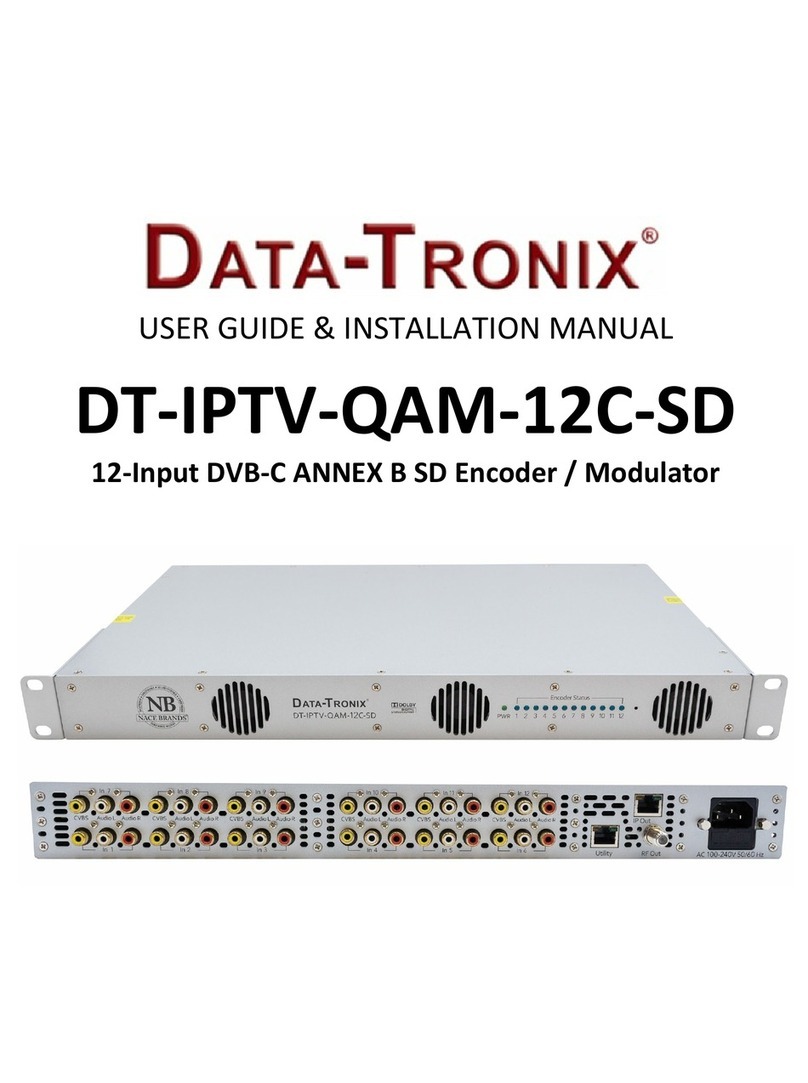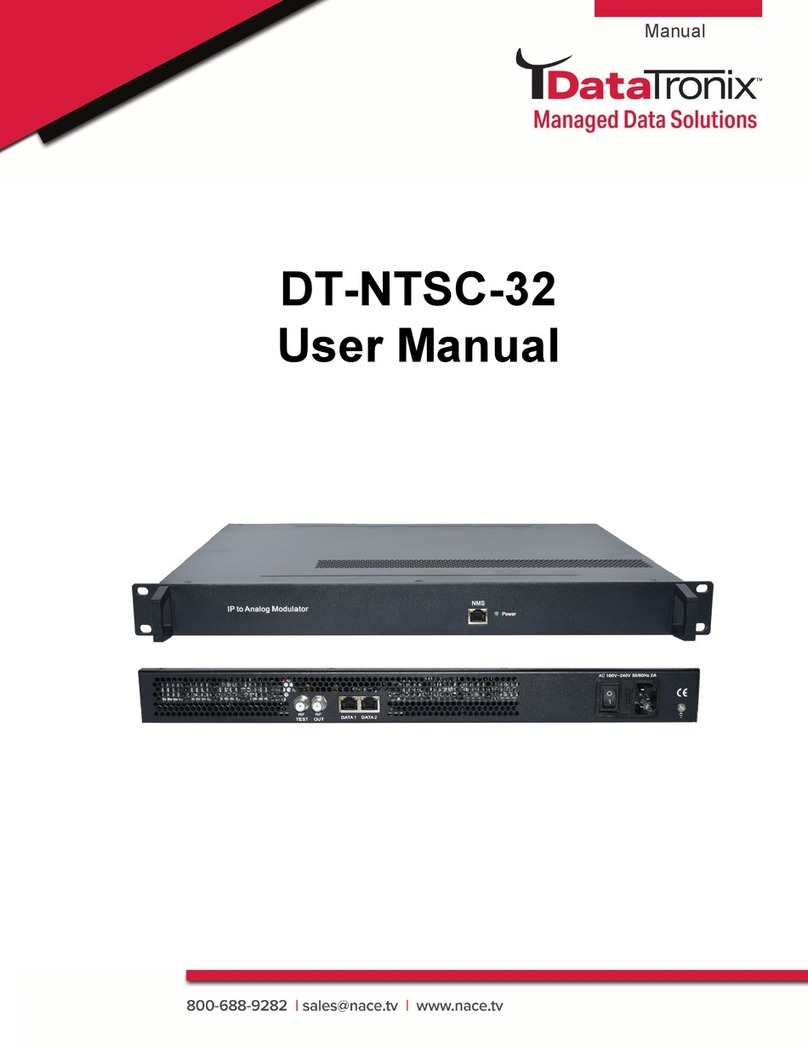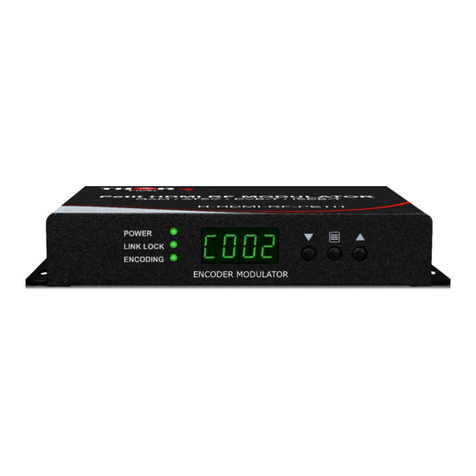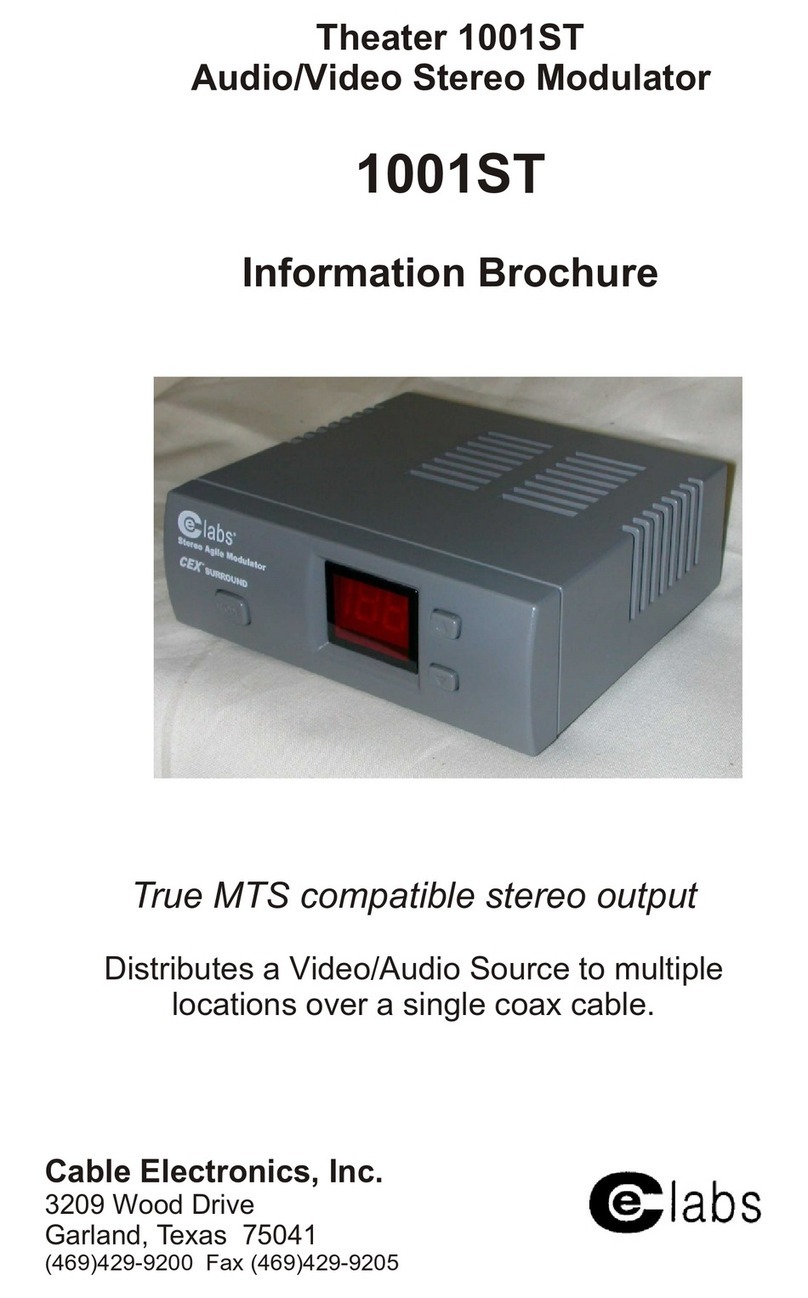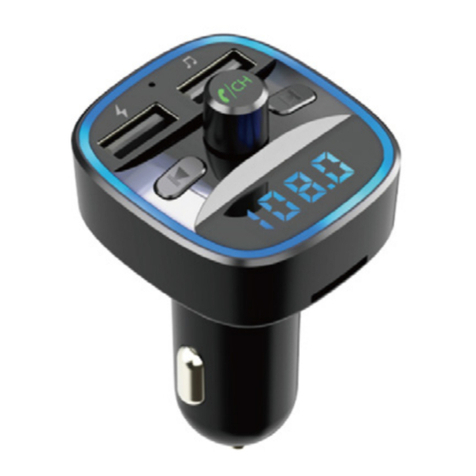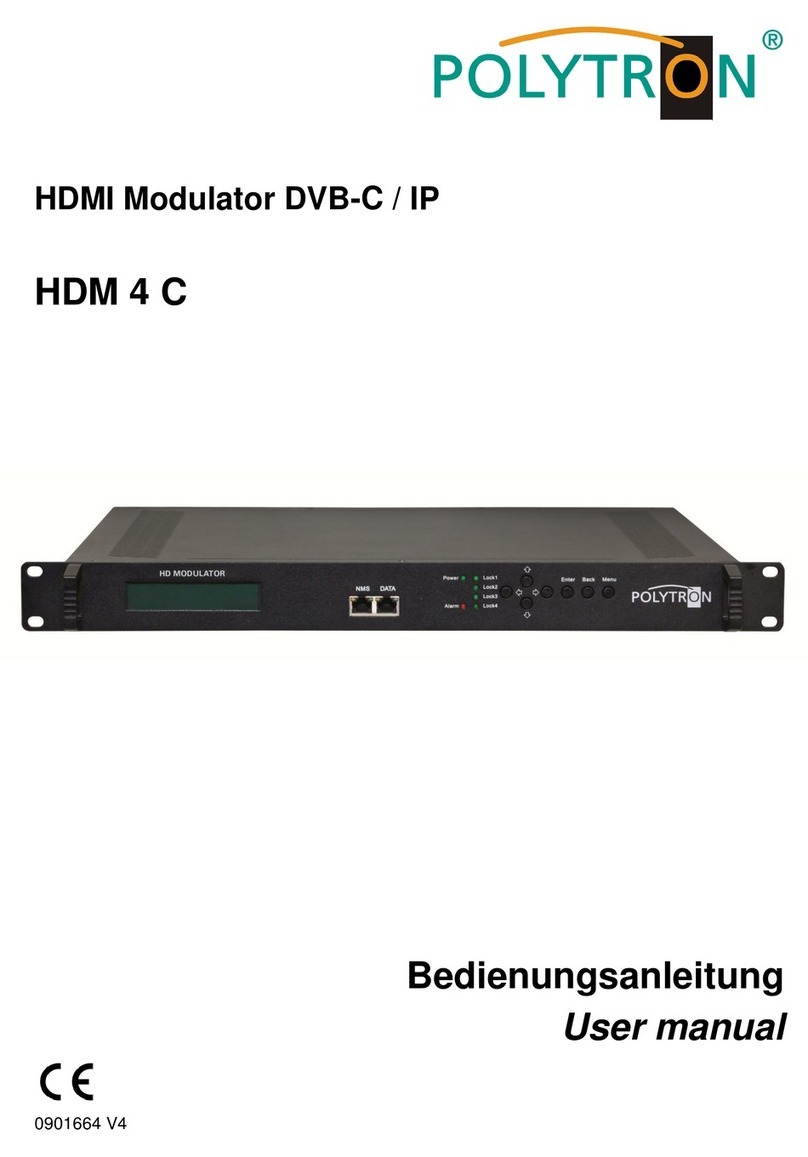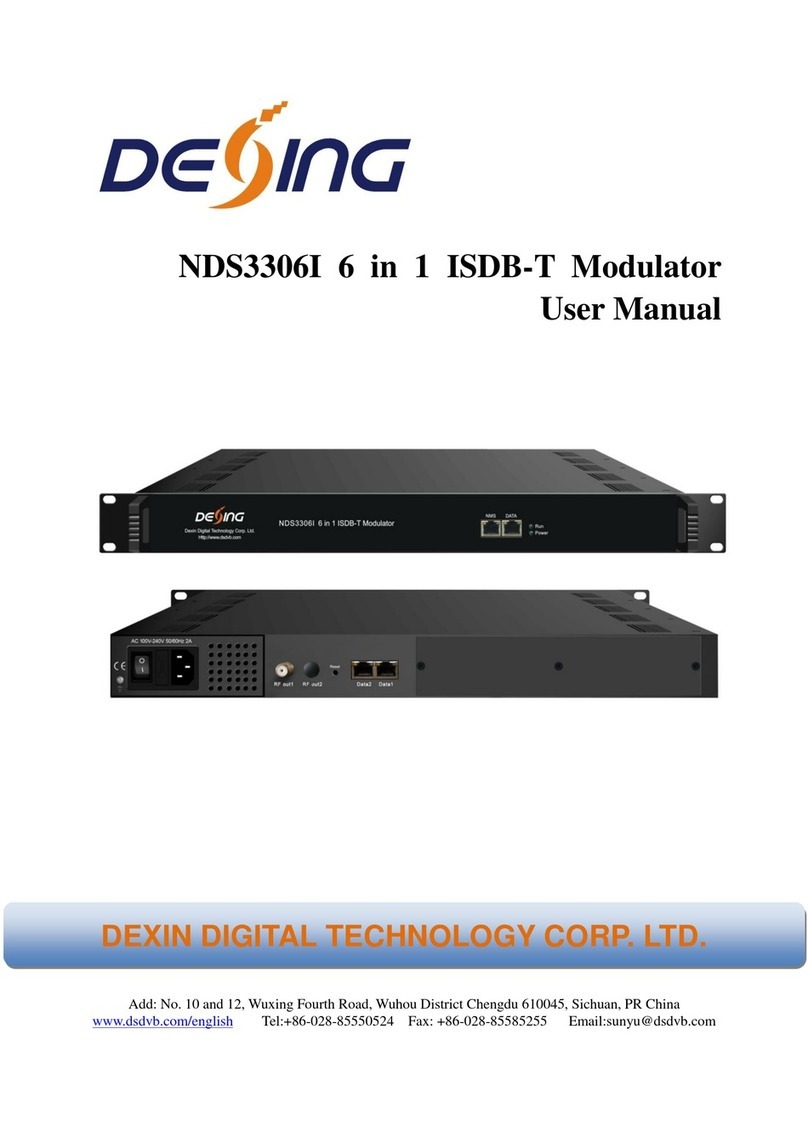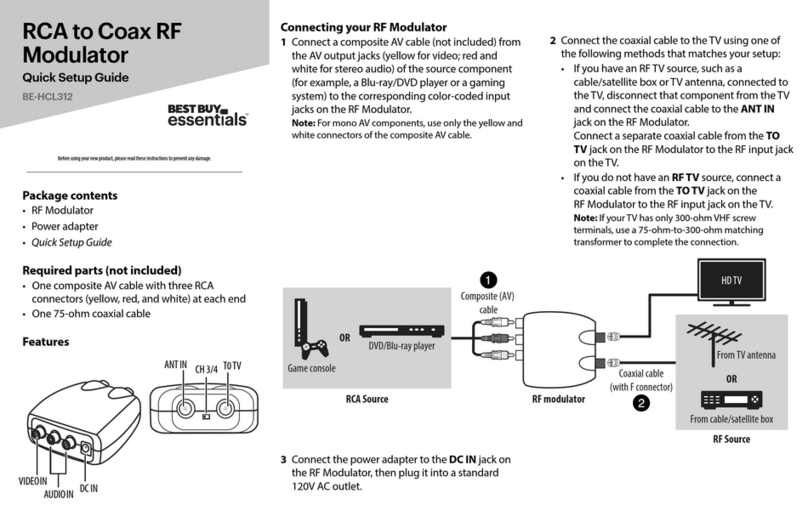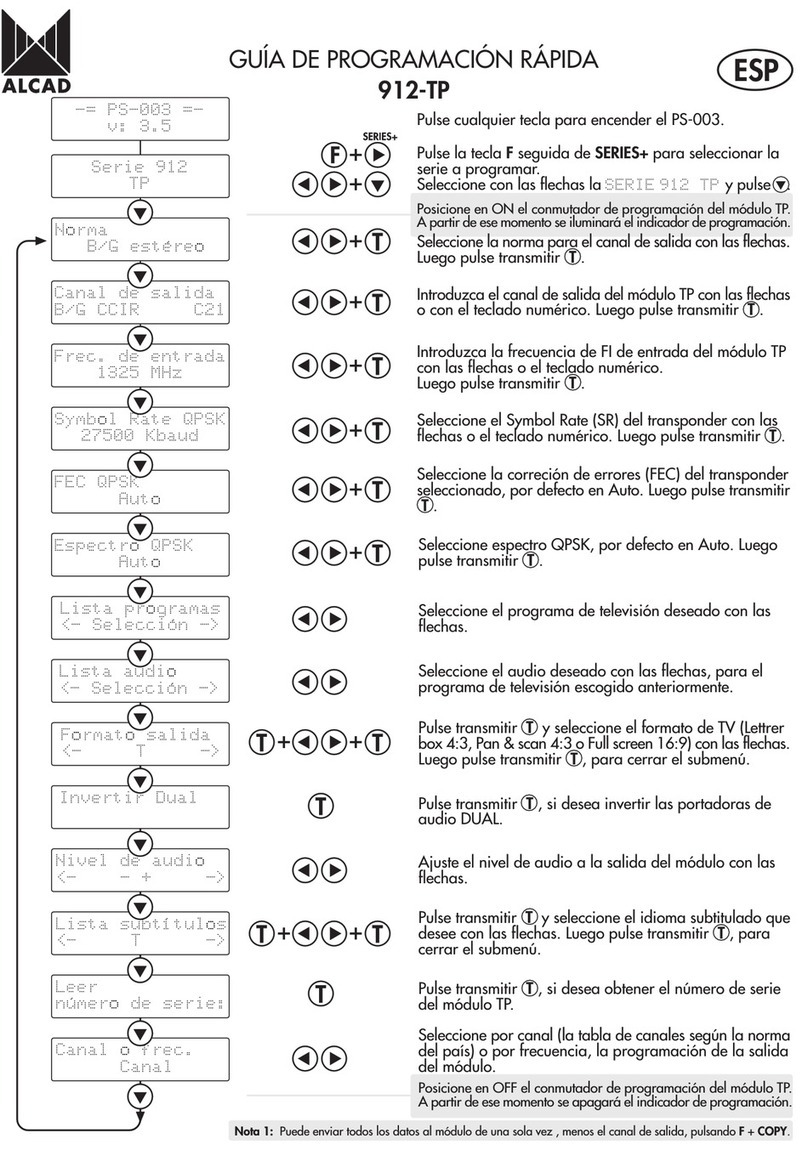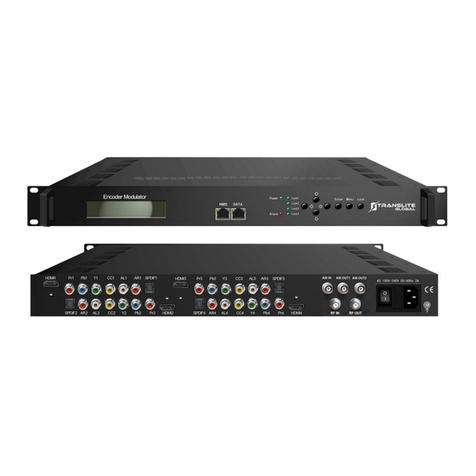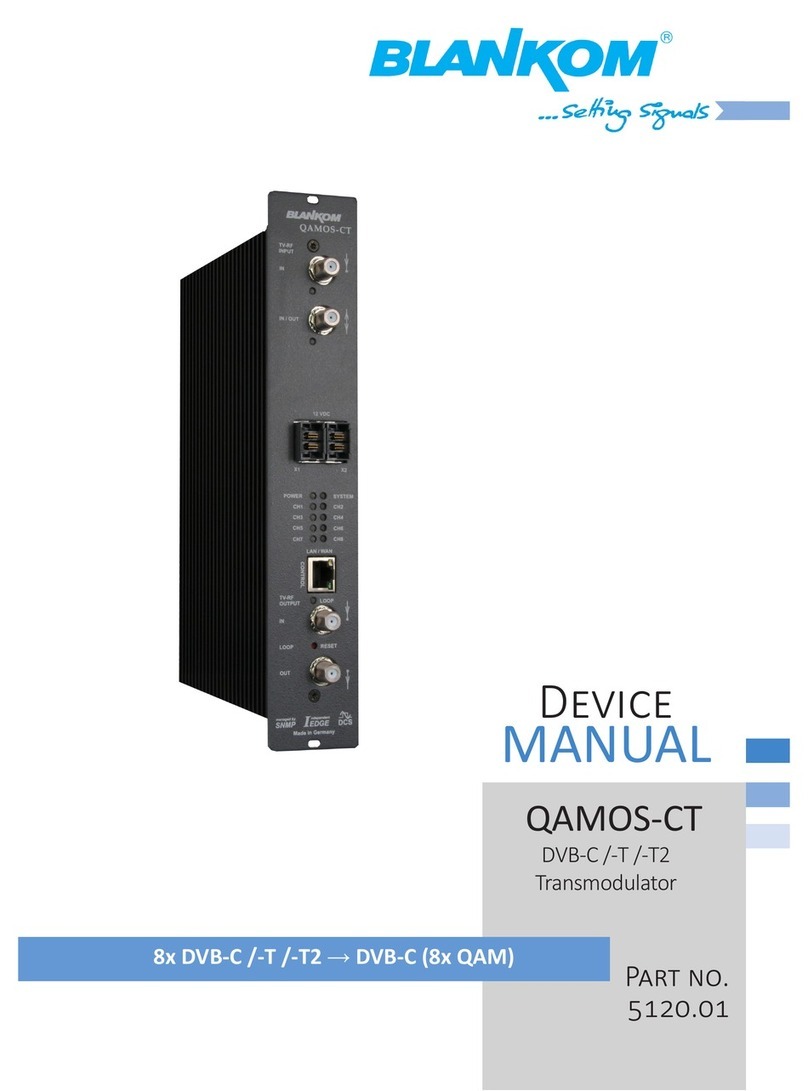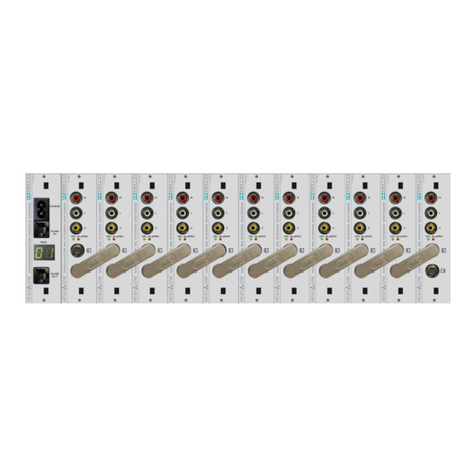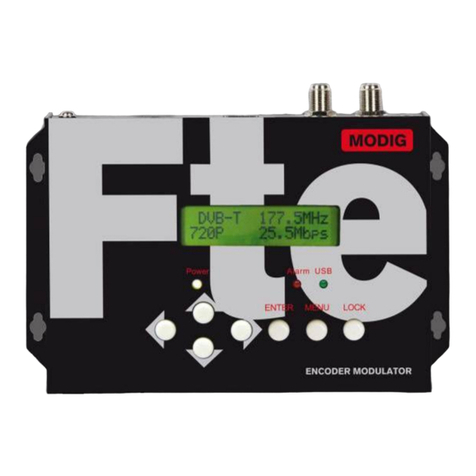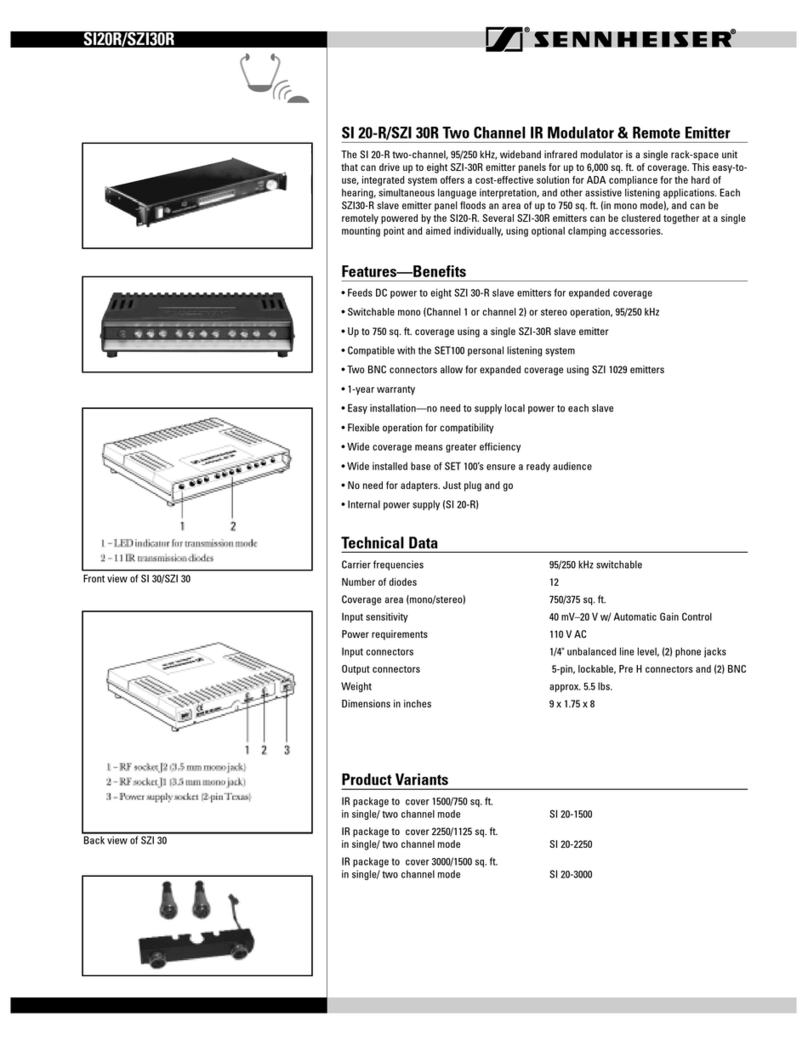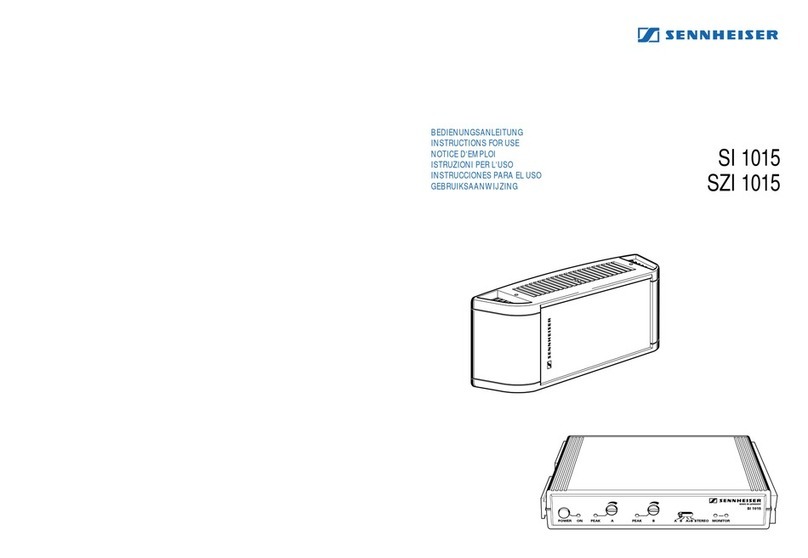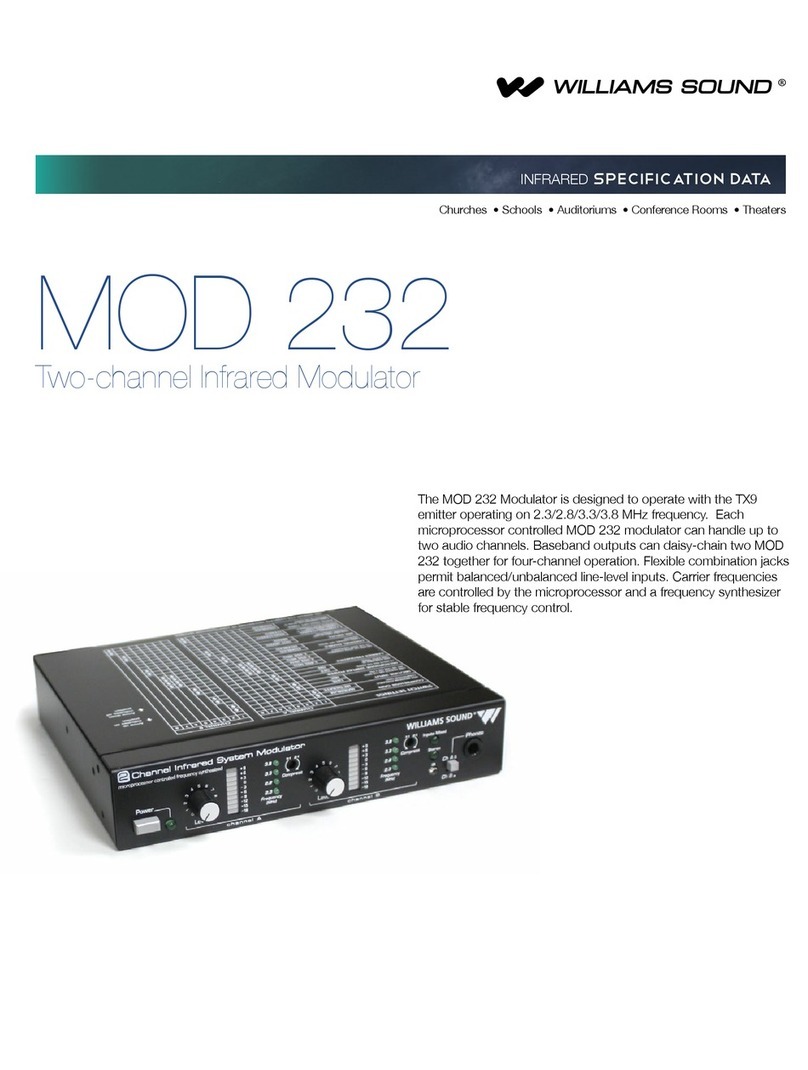Data-Tronix DT-ATSC-QAM-8V2 User manual

Manual
8 input ATSC-8VSB / QAM-B to QAM-B
Trans-Modulator
DT-ATSC-QAM-8V2
User Manual

2
DT-ATSC-QAM-8V2 Manual
Table of Contents
Safety Precautions ................................................................................................................. 3
Package Contents.................................................................................................................. 3
Unpacking and Inspection ...................................................................................................... 4
Installation ............................................................................................................................. 4
Introduction to DT-ATSC-QAM-8V2: ATSC-8VSB / QAM-B to QAM-B Trans-Modulator ............ 4
Features........................................................................................................................ 4
System Parsing / Response Time................................................................................... 4
Specifications ................................................................................................................ 5
Hardware Installation ............................................................................................................. 6
Device Programming and Setup ............................................................................................. 6
Connecting to the GUI Interface ..................................................................................... 6
Factory Default IP: 192.168.1.9...................................................................................... 6
System Setup via GUI Interface ..................................................................................... 6
Name: admin / Password: Admin123 ............................................................................ 6
Overview Page ................................................................................................................... 7-9
Ingest Setup ........................................................................................................................ 10
Streaming Setup .................................................................................................................. 11
Streaming System Parameters ..................................................................................... 12
Customize the Streaming Setup View........................................................................... 13
RF Output Setup.................................................................................................................. 14
Network Setup ..................................................................................................................... 15
Device IP Address Setup ............................................................................................. 15
Forgot IP Address........................................................................................................ 16
System Setup ...................................................................................................................... 16
Description .................................................................................................................. 16
Time / NTP Server Setup ............................................................................................. 17
Administration ...................................................................................................................... 17
Reboot ........................................................................................................................ 17
Reset to Default........................................................................................................... 17
Backup........................................................................................................................ 18
Restore ....................................................................................................................... 18
Firmware Update ......................................................................................................... 19
Change Password ...................................................................................................19-20
Private Address Ranges, IPv4 .............................................................................................. 20
Warranty..........................................................................................................................21-22

3
DT-ATSC-QAM-8V2 Manual
Safety Precautions
The presence of this symbol is to alert the installer and user to the presence of uninsulated
dangerous voltages within the product’s enclosure that may be of sufficient magnitude to
produce a risk of electric shock.
TO REDUCE THE RISK OF FIRE OR ELECTRIC SHOCK, DO NOT EXPOSE THIS DEVICE
TO RAIN OR MOISTURE. DO NOT OPEN THE UNIT. REFER SERVICING TO QUALIFIED
PERSONNEL ONLY.
• DO NOT apply power to the unit until all connections have been made, all components have
been installed and all wiring has been properly terminated.
• DO NOT terminate, change or uninstall any wiring without first disconnecting the unit’s
power adapter from the device.
• This device is supplied with the appropriately rated power supply. The use of any other
power supply could cause damage and invalidate the manufacturer’s warranty.
• DO NOT connect the power cord to the device if the power cord is damaged.
• DO NOT cut the power cord.
• DO NOT plug the power cord into an AC outlet until all cables and connections to the device
have been properly connected.
• The device should be installed in an environment consistent with its operating temperature
specifications. Placement next to heating devices and ducts is to be avoided as doing so
may cause damage. The device should not be placed in areas of high humidity.
• DO NOT cover any of the device’s ventilation openings.
• DO NOT cover or obstruct the device’s fan or fan openings.
• If the device has been in a cold environment allow it to warm to room temperature for at
least 2 hours before connecting to an AC outlet.
Package Contents
➢One DT-ATSC-QAM-8V2
➢One Power Cable
➢One Installation / Configuration Manual

4
DT-ATSC-QAM-8V2 Manual
Unpacking and Inspection
Each unit is shipped from the factory tested. Ensure all items are removed from the container
prior to discarding any packing material.
Thoroughly inspect the unit for shipping damage with particular attention to connectors and
controls. If there is any sign of damage to the unit or damaged or loose connectors contact your
distributor right away.
Installation
System Installer must adhere to Article 820-40 of the NEC that provides guidelines for proper
grounding and specifies that the cable ground shall be connected to the grounding system of
the building, as close to the point of cable entry as possible.
Introduction to DT-ATSC-QAM-8V2: ATSC-8VSB / QAM-B to QAM-B Trans-Modulator
The DataTronix DT-ATSC-QAM-8V2 is a high quality 8VSB /Clear QAM to QAM Trans-
modulator. It was designed to allow system integrators to receive and process up to 8 individual
8VSB (ATSC) / Clear QAM channels along with up to 56 sub channels, and easily convert these
signals to produce a high-quality RF QAM distribution system. The DT-ATSC-QAM-8V2 is a
highly flexible system allowing integrators to quickly receive, convert, and distribute high quality
Digital QAM channels to their customers.
Features
✓Accepts 8 RF inputs (ATSC-8VSB/QAM)
✓Allows for Up to 64 Output Programs
✓Allows User to “Cherry Pick” Desired Programs as Needed
✓Supports STD/HRC/IRC Formats
✓Supports Full Range of ATSC-8VSB/QAM Signals
✓Offers 8 Fully Independent RF QAM Outputs
✓Easy to Setup and Monitor with GUI
✓Front Panel LED Indicators
✓3 VCN Modes Supported
✓High Density 1RU Design
System Parsing / Response Time:
The initial System Parsing time will range from 4-6 minutes on average as the system identifies
and populates the required parameters. As the user navigates the device's menu note that a
small delay may occur in populating the data on the screen as the system is constantly
performing system parsing and system house-keeping functions.

5
DT-ATSC-QAM-8V2 Manual
Input
RF Mode (ATSC-8VSB and QAM)
Connector 1 x F-Type, Female
Input Impedance 75 ohm
Modulation
ATSC-8VSB
ITU J.83 Annex B
(64-QAM,
256-QAM)
Tuning Block Freq
.Range 55 to 861MHz (Center)
Bandwidth 6 MHz
Numbers of Tuner
8
Input Level
6 MHz
Loop Through
Connector 1 x F-Type, Female, Passive
Web Management
GigE
Connector 1 x RJ45
Standard 100 / 1000Base-T Ethernet,
Full / Half Duplex,
Auto-Negotiation
HTTP Embedded
Emergency Alert System (EAS) (Optional)
GigE
Connector 1 x RJ45
Standard 100 / 1000Base-T Ethernet,
Full / Half Duplex, Auto-
Negotiation
UDP / RTP Supported (user-selectable)
Protocol SCTE-18 Supported
Output
QAM
Connector 1x “F” Female
Modulation 256-QAM / 64-QAM
Standard J.83 Annex B
Frequency Range 57 to 861 MHz (Under
STD Mode)8
Independent RF
Frequencies
Channels’ Bandwidth 6 MHz
Output Level 45 dBmV Typical
Output Impedance 75 ohm
Level Adjustment 0 to -20 dB
VCN Auto (Major & Minor)
Manual (Major & Minor)
Manual (One Part)
Carrier Suppression 55 dB
RF Output Return Loss
10 dB Typical
Signal-to-Noise Ratio
(SNR) 42 dB Typical
MER 41 dB Minimum, 44 dB Typical
Alarms / Monitoring
Local Monitoring 8 x NIM Status LEDs /
1 x Power LED
Local Control IP Reset Button
GUI Supported Firefox, Chrome
Password Protected GUI: Changeable
Power
Power Supply 12VDC 5.4Amp.
Consumption
23 W Typical
Input Voltage Range 100 to 240 VAC
Mechanical and Environmental
Chassis (W x D x H) 19.01 x 9.45 x 1.74"
(483 x 240 x 44.2 mm)
Weight 7.9 lbs.
Operating Temperature 32 to 122°F (0 to 50°C)
Storage and
Transportation
Temperature
32 to 140°F (0 to 60°C)
Language English
Warranty 1-Year Limited Warranty
**Specifications Subject to Change Without Notice.**

6
DT-ATSC-QAM-8V2 Manual
Hardware Installation
1. Use properly installed terrestrial antennas. Verify for proper signal reception and signal
levels.
2. Properly connect required outputs of terrestrial antennas/splitter feeds
to the DT-ATSC-QAM-8V2.
3. Apply Power to the DT-ATSC-QAM-8V2.
4. Connect an Ethernet cable from Utility Port on the DT-ATSC-QAM-8V2 to a PC/MAC.
Device Programming and Setup
Connecting to the GUI Interface
1. Connect an Ethernet Cable directly to the Utility Port on the rear panel of the device or
connect the Ethernet cable to an Ethernet switch. Connect an Ethernet cable to Your
PC/Laptop
2. Modify Your PC/Laptop IPV4 address to 192.168.1.11
3. Enter Default IP Address for DT-ATSC-QAM-8V2 into Your W eb Browser
(Suggested browser: Firefox or Chrome)
Factory Default IP: 192.168.1.9
System Setup via GUI Interface
After connecting the device to the GUI interface (please see descriptions above):
1. Enter device's IP address in web browser.
2. Login: Enter unit Name/Password
Name: admin / Password: Admin123
Note: To modify the system
password, go to the
[Administration Page] of the
device.

7
DT-ATSC-QAM-8V2 Manual
Overview Page
[Overview Page] provides an overall system status of the DT-ATSC-QAM-8V2 including:
RF Input Type, Frequency, SNR, Signal Status, and Programs**.
**Programs : If you move your cursor to “ ” you will see the detailed information (see figure
below as example) of the Programs.

8
DT-ATSC-QAM-8V2 Manual
Overview (RF Output): RF Outputs showing the number of sub-streams/programs

9
DT-ATSC-QAM-8V2 Manual
Overview (Fan): This tab shows fan status and system uptime

10
DT-ATSC-QAM-8V2 Manual
Ingest Setup
Use the [Ingest Setup] page to configure each input. Up to 8 individual - ATSC or QAM inputs
can be assigned.
Ingest Setup Procedures
1. Select Ingest setup tab from the top menu
2. Select the appropriate ingest input (1 thru 8). Enable as required
3. Select Standard: ATSC or QAM
ATSC: 8VSB / QAM: STD / QAM: HRC / QAM: IRC
4. Select Constellation: For QAM select 64-QAM or 256-QAM as required
5. Select Frequency (MHz) (Input)
ATSC-8VSB: UHF (CH 14 – 69) VHF (CH 2-13)
QAM: CH 2 – CH 135 (57 MHz to 861 MHz)
6. Save and Confirm to save all changes
*****Note: Leaving any ingest setup page without saving the set parameters will cause
the device to revert to the last saved settings.

11
DT-ATSC-QAM-8V2 Manual
Streaming Setup
Use the [Streaming Setup] page to set the output: SID, Select VCN Mode Type, VCN, Short
Name, and other parameters.
Enable / Select / and Setup Streams
1. Enable each stream/program as required by checking the check box
Note: To remove a stream/program - deselect/uncheck the stream(s) #
on the left side of the table
2. Modify SID (Services Output ID)
Note 1: If installing multiple DT-ATSC-QAM-8V2 units make sure not to duplicate SID
outputs
Note 2: Enter SID for a program and the followed programs will be assigned by consecutive
numbers
3. Enter Short Name [1-7 Characters]
4. Enter Long Name [1-16 Characters]
5. Select VCN Mode:
VCN Mode 2-Part Auto [Example 102.1 – Set Automatically by the Device]
VCN Mode 2-Part Manual [102.2 – Manual Entry by User]
VCN Mode 1-Part Manual [102 – Manual Entry by User]
Note: Only 1 VCN mode type can be selected
6. Modify Source ID as required
Note: If installing multiple DT-ATSC-QAM-8V2 units make sure not to duplicate source ID
outputs
7. Select RF# from 1-8 to assign programs to desired carrier
Note 1: Bitrate mapping may be required based on the Mbps of the streams/programs in
the RF Out
Note 2: Use the streaming setup page to move program(s) as needed to allow for
increased overhead of required programs
8. Save and Confirm all parameters
*****Note: Leaving any Streaming Setup page without saving the set parameters
will cause the device to revert to the last saved settings

12
DT-ATSC-QAM-8V2 Manual
Streaming System Parameters
Input
Input No. Total Input Number Received by Tuner
PMT PID Program Map Table PID
Video PID Video Stream PID
Audio PID Video Stream PID
TS ID Input Transport Stream ID
SID Service ID (Program ID)
Short Name From Content Provider
Long Name From Content Provider
Bit Rate Input Bit Rate
Output
SID Service ID - Definable
PMT PID Program Map Table PID
Video PID Video Stream PID
Audio PID Audio Stream PID
Short Name Definable [1-7 Characters]
Long Name Definable [1-16 Characters]
VCN Mode Selectable (Auto 2-Part, Manual 2-Part,
Manual 1-Part.)
VCN Definable (W hen Using Manual VCN Modes)
Source ID# Definable

13
DT-ATSC-QAM-8V2 Manual
Customize the Streaming Setup View
The [Streaming Setup] parameters page is easily customizable for each system.
To customize the parameters shown:
1. Select “Select Columns” tool
2. Add or remove parameter as needed by selecting or deselection
3. Close window after selecting / deselecting parameters

14
DT-ATSC-QAM-8V2 Manual
RF Output Setup
Use the [RF Setup Page] to properly setup each RF output channel.
1. Enable / Disable RF output as required.
2. Enter TS_ID (Transport Stream ID) value.
3. Enter regional name as required
4. Select RF type [Normal, Inverted, C.W.]
5. Select Channel type [STD, HRC, IRC]
6. Set CH/Freq. [CH 2 – CH 135 / Freq. 57MHz ~ 861MHz]
Note: DT-ATSC-QAM-8V2 is frequency agile
7. BW: factory set [6MHz]
8. Set attenuation [ 0 ~ -20dB. 1dB Steps]
9. Select constellation [64-QAM , 256-QAM]
10. Select interleaver – change as required.[Default: I=128, J=1]
11. Save and Confirm all changes
Note 1: Bitrate Mbps shown allows the integrator to quickly review assigned stream
bitrate allocated and Capacity
Note 2: Bitrate mapping may be required based on the Mbps of the streams/programs
in the RF Out
Note 3: Use the [Streaming Setup Page] to move program(s) as needed to allow for increased
overhead of required programs
Note 4: Leaving any [RF Output Setup Page] without saving the set parameters will cause
the device to revert to the last saved settings

15
DT-ATSC-QAM-8V2 Manual
Network Setup
Device IP Address Setup
1. Select network setup tab to manage the IP address of the device
2. Modify hostname as required
3. Select DHCP or static IP
4. For Static IP: select static IP and enter static IP address for device
5. Enter Subnet Mask
6. Enter Default Gateway
7. Enter DNS Server 1 address
8. Enter DNS Server 2 address (if required)
9. Save and Confirm all changes

16
DT-ATSC-QAM-8V2 Manual
Forgot IP Address
You can return to the default IP address (factory default) setting from via front panel by following
the steps below:
1. Press the Reset button from the front panel (Circled in Picture Below)
2. Power on the unit
3. Release the reset button once the power LED stops flashing and become static green
4. Unit’s IP address will revert back to default IP: 192.168.1.9
5. Unit’s login data will revert back to factory default
Name: admin / Password: Admin123
Note: ONLY THE IP ADDRESS WILL REVERT BACK TO DEFAULT SETTING,- NO
CHANGES WILL BE MADE TO THE CONFIGURATION
System Setup
Description
Use the [System Setup Page] to designate location and description
of the DT-ATSC-QAM-8V2 unit.
Reset Button

17
DT-ATSC-QAM-8V2 Manual
Time / NTP Server Setup
Use the time tab to set the units system time and time zone and NTP Server.
1. Select time tab on system setup page
2. Select time zone from the drop-down tool
3. Enter NTP Server 1 / 2 addresses as required
4. Select synchronize system with PC clock as required
5. Select apply to apply all changes
Administration
Reboot
Use the Reboot button to reboot the device. No parameters will be changed.
Reset to Default
Use the Reset to Default button to reset all parameters to original factory settings.

18
DT-ATSC-QAM-8V2 Manual
Backup
We highly recommend saving your device’s setting.
1. Select administration tab
2. Select backup from the menu
3. User can choose which data required backup from the following pages: Ingest setup /
Streaming Setup / RF Out Setup / Network Setup / System Setup
4. Locate and Name file for future use
Note: The backup can be imported to assist in setting up new or multiple devices onsite.
Remember to Save and backup any and all changes.
Restore
1. Select administration tab
2. Browse the required file to be imported
3. Select “Upload” to import the selected file into the device
******Note: Do not power off the unit while importing.

19
DT-ATSC-QAM-8V2 Manual
Firmware Update
Use the Firmware Upgrade section to import new FW version.
1. Select administration tab
2. Select firmware upgrade tab
3. Browse to locate the required image file to be uploaded
4. Select “Upload” to import the selected file into the device
*******Note: Do not power off the unit while importing.
Change Password
Use the password section to change or modify the device’s password as desired.

20
DT-ATSC-QAM-8V2 Manual
1. Select administration tab
2. Select password tab
3. Follow listed instructions
4. Save and Confirm to apply new password.
Private Address Ranges, IPv4
Private IPv4 addresses are addresses set aside by the IANA (Internet Assigned Numbers
Authority) for use within networks that will not directly communicate or be seen by the internet.
These private addresses cannot be used on the Internet or be used to communicate with the
Internet. ISP’s filter out and delete packets using private IP addresses.
Any organization that uses private IP addresses on devices that communicate with the internet
must use a device that performs Network Address Translation.
Anyone can us private addresses and they are not required to seek permission to use them.
Again, networks using private IP addresses cannot communicate directly with the internet.
There are three blocks of addresses that are set aside by IANA for use in private internets and
are not publicly routable on the global internet:
Private Class A Range: 10.0.0.0 -10.255.255.255
Private Class B Range: 172.16.0.0 -172.31.255.255
Private Class C Range: 1 92.168.0.0 -192.168.255.255
It is important to note that only some of the 172.xx.xx.xx and the 192.xx.xx.xx address ranges
are designated for private use. The remaining addresses are public and can be routable via the
global Internet.
More information regarding private addresses can be found at http://www.iana.org and
https://www.arin.net.
This manual suits for next models
1
Table of contents
Other Data-Tronix Modulator manuals
